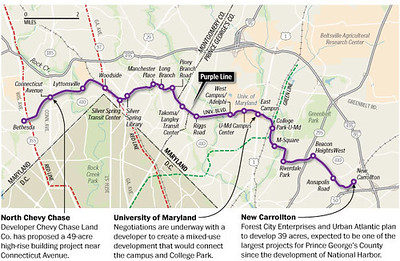Because I misread this, I thought it was a big deal. It wasn't and it proves the point I made in 2014 about the need for Montgomery and Prince George's County to create a Purple Line focused community development corporation
Hampshire Village in Langley Park.
I guess my eyesight is going because when I first saw this Washington Post article headline, "JPMorgan Chase commits $5 million to combat gentrification along the Purple Line," I read million as billion. First I thought it was a big deal, at $5 billion. But $5 million for "fighting gentrification" in a rail corridor that will have 20 stations over 16 miles is a drop in the barrel. From the article:
A major national bank has committed $5 million to nonprofits to support affordable housing and small businesses threatened by development expected to follow the Purple Line being built in Washington’s Maryland suburbs.
The award by JPMorgan Chase, announced Tuesday, is the largest grant so far for efforts to combat gentrification that could displace residents along the 16-mile route of the light-rail linelinking Bethesda in Montgomery County and New Carrollton in Prince George’s County.
The investment, spread over three years, aims to help preserve or create 1,000 affordable homes, according to a draft news release obtained by The Washington Post.

And that's the point I made going to conferences on the Purple Line sponsored in 2014 by the University of Maryland National Center for Smart Growth.
-- "To build the Purple Line, perhaps Montgomery and Prince George's Counties will have to create a "Transportation Renewal District" and Development Authority"
-- "Quick follow up to the Purple Line piece about creating a Transportation Renewal District and selling bonds to fund equitable development"
Victoria Crossing apartments, Langley Park.
Although it turns out I made the same point in 2009. (Although changes to the google and blogger search functions make it virtually impossible to find the link at the moment.)
This point later was the foundation of a related concept, the creation of tax increment financed "public improvement districts" for transit station catchment areas as a matter of course. PIDs are a pretty common technique, but are not often integrated into transit line development programs.
-- "Public improvement districts ought to be created as part of transit station development process: the east side of NoMA station as an example," 2016
And of course, I restated it as part of the 2017 series on focused leveraging of the Purple Line infrastructure program to drive economic development and transportation improvements more broadly:
-- "Part 6 | Creating a transportation development authority in Montgomery and Prince George's County to effectuate placemaking, retail development, and housing programs in association with the Purple Line"
Basically, you need an entity that can buy, hold, finance, intensify, and build if necessary housing and commercial property in the Purple Line corridor, if you want to accomplish multiple objectives that are sometimes counter to each other, such as growth vs. limitations on displacement; growth of rent asking prices (seen as a benefit from the standpoint of real estate ownership) vs. maintenance of low rents, etc.
Creating a Bi-County Redevelopment Authority with bonds (tax increment financing) sold "against" a Transportation Renewal District comprised of the catchment area of the Purple Line light rail line in Montgomery and Prince George's Counties, Maryland
1. The idea is to create a companion "Revitalization District" that wraps around the newly created transportation infrastructure, and create a "Tax Increment Financing" program to raise a very large fund, which could increase significantly the velocity of revitalization, and to purposefully fund the kinds of equitable development activities espoused by the Purple Line Corridor Coalition.

2. Rather than creating a variety of micro-TIF districts for various projects, this proposal is for a large single fund, but with a detailed program facilitating projects at various scales and locations, but using the large tax district as a way to realize projects across all parts of the catchment area, including areas where current demographics and economic conditions wouldn't normally support financing for such projects.
3. Originally I did not foresee using TRD monies to fund the construction of transit infrastructure per se, but to fund new property development by both for profit and nonprofit entities, property acquisition to maintain long term affordability, civic infrastructure, and community improvement programs of various types.
Now I would include transit network improvements as eligible for funding, and would even consider using a portion of the revenue stream to fund the actual construction of the Purple Line specifically.
4. The lessons from DC and Portland's use of an Urban Renewal District to fund some of the local match for its Yellow Line light rail is that it takes 30-40 years to see fully the impact of the transit line on ancillary investment, so the TRD needs to be set up to last a long time--typically an urban renewal district's funding is for a 20 year period and then ceases, although Portland has a process for extending the period.
5. Recognizing that new development results in new costs for existing systems like emergency services and schools, "all" of the forecasted increase in property taxes should not go to the TRD, some of the stream should be reserved and fund such services.
6. Action plans would need to be created, along with the right accountability mechanisms and marketing systems, along with some flexibility to respond to changes in market conditions, circumstances, and opportunities as they development. A supra-prescriptive plan isn't the right course, but a set of "transformative projects" should be part of the program (see "(Big Hairy) Projects Action Plan(s) as an element of Comprehensive/Master Plans"--now I am calling such plans, "Transformational Projects Action Plans").
Labels: affordable housing, equity, gentrification/displacement, real estate development, suburban revitalization, transit infrastructure, transit oriented development, urban design/placemaking





0 Comments:
Post a Comment
<< Home